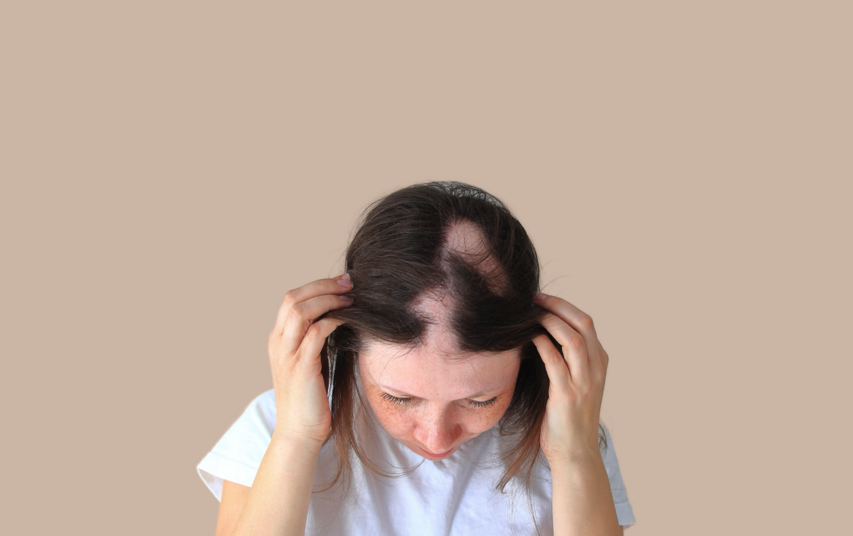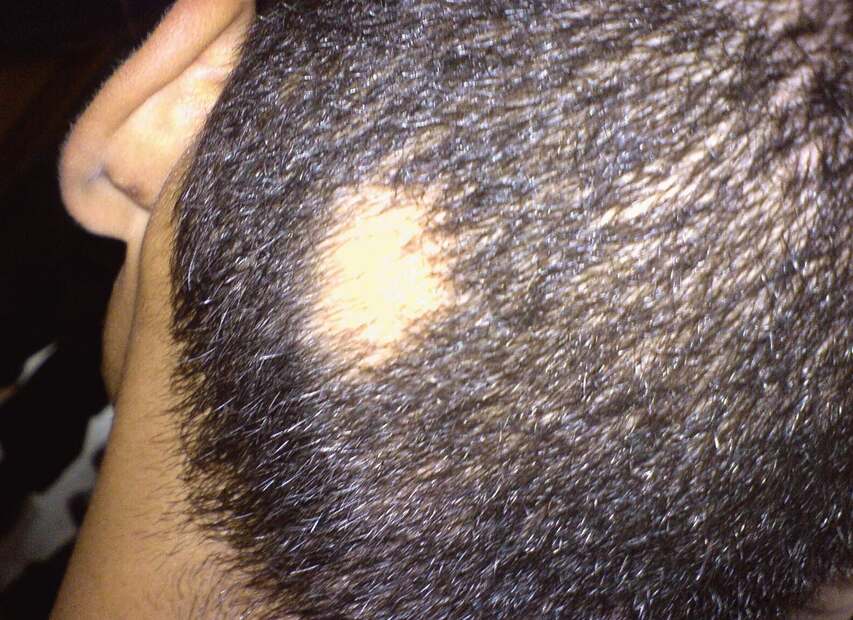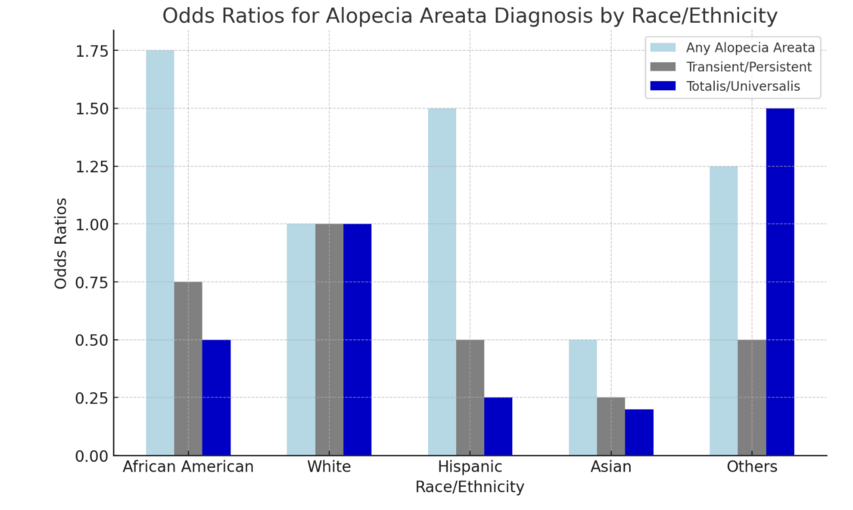Alopecia areata - best treatment according to dermatologists

What is alopecia areata?
Alopecia is the medical term for baldness. Areata means patches. Alopecia areata causes smooth, round bald patches to develop on the scalp, beard, eyebrows, eyelashes, or armpits. In 10% of people with alopecia areata, the patchy baldness can develop into total baldness (alopecia totalis) or hair shedding from all body areas (alopecia universalis).
What causes alopecia areata?
The exact cause of alopecia areata is still unknown. Most evidence supports an autoimmune origin, genetic tendency, and external factors. It is believed that in people with alopecia areata, the immune system mistakenly attacks the hair follicles, reducing their ability to produce new hair. Studies have shown that 10-25% of people with alopecia had a relative with the same disorder.
Types of Alopecia Areata

Abbassyma at English Wikipedia, Public domain, via Wikimedia Commons
1. Patchy Alopecia Areata: This is the most common form of alopecia areata, characterized by round or oval bald patches on the scalp or other hair-bearing areas of the body. These patches are usually smooth and devoid of hair.
2. Alopecia Totalis: About 10% of individuals with alopecia areata progress to alopecia totalis, which is complete baldness on the scalp.
3. Alopecia Universalis: Alopecia universalis is the most severe form of alopecia areata, resulting in complete hair loss not only on the scalp but also on other hair-bearing areas, including the eyebrows, eyelashes, beard, and body hair.
Is alopecia areata related to other health conditions?
People with alopecia areata are more likely to have other autoimmune diseases such as autoimmune thyroid disorder (8-28% in different studies) or vitiligo (2.5% to 4.1% in further studies). People with alopecia areata also tend to have sensitive skin or atopic dermatitis (40% vs. only 20% in the general population).
Alopecia areata in different ethnicities
Alopecia areata shows varying prevalence among different ethnicities, with African Americans and Hispanics reporting higher incidences than Caucasians.

Based on an analysis of 1,970 cases and 2,064 noncases from the National Alopecia Areata Registry. J Am Acad Dermatol, July 3, 2019.
What is the best treatment for alopecia areata?
Unfortunately, there is no quick fix for alopecia areata. Most people think the hair will regrow on its own after 10-12 months. That said, in some cases, medicated and natural treatments can help the hair grow back more quickly.
Topical minoxidil
Minoxidil is a topical solution approved by the FDA to treat hair loss in men and women. It works by increasing blood flow to the scalp, increasing the supply of oxygen and micronutrients in the hair follicles. Recent studies have shown that minoxidil can also help hair regrowth in people with alopecia areata. It was also demonstrated that combining minoxidil with oral steroids can help limit post-steroid hair loss.
Topical corticosteroids
Topical corticosteroids can suppress the immune system's overactivity on the scalp, allowing the hair follicles to resume hair growth.
Anthralin
Anthralin is a cream that irritates the skin to stimulate hair regrowth. It is a tar-like cream that has been used to treat psoriasis in the past.
MDhair Restore Serum (plant-based alternative)
A healthy scalp is the key to healthier and faster hair regrowth. The MDhair Restore Serum stimulates blood circulation in the scalp, adds essential vitamins and minerals needed for hair regrowth, and acts as an antioxidant to reduce the harmful effects of toxic chemicals and air pollution.
Steroid injections
Steroid injections to the bald areas can stimulate temporary hair regrowth. These painful injections must be repeated every two months to regrow hair.
Hair supplements
Serum vitamin D, Zinc, and folic acid levels tend to be lower in patients with alopecia areata than in controls. There is conflicting evidence about differences in iron, vitamin B12, copper, magnesium, or selenium levels. The MDhair Restore Supplements were specially formulated to support hair regrowth. They contain a powerful formula featuring biotin, vitamin C, vitamin E, vitamin B6, vitamin B12, pantothenic acid (vitamin B5), iron, magnesium, Zinc, selenium, manganese, and chromium to replenish depleted micronutrients and support new hair regrowth.
Can Zinc help people with Alopecia Areata?
Some studies have found an association between low serum zinc levels and alopecia areata, suggesting that zinc deficiency may play a role in the development of the condition. A review article reported that four out of six case-control studies found low zinc levels in patients with alopecia areata compared to healthy controls. Another study showed a strong correlation between zinc deficiency (< 70 µg/dL) and hair loss. Some studies indicate a potential link between zinc deficiency and alopecia areata, but the evidence is mixed, and the role of zinc supplementation remains open to debate.
What is the best daily hair care routine for people with alopecia areata?
For best results, dermatologists recommend a routine that includes minoxidil or a plant-based scalp treatment solution, an active shampoo, and oral supplements. You may also want to consider taking collagen peptides.
What can I do to manage my alopecia?
- Use a soft-bristled hairbrush and wide-toothed comb to protect your scalp from damage.
- Avoid using harsh chemicals and heat hairstyling.
- Avoid ponytails and other tight hairstyles
- Increase your protein and vegetable intake.
- Reduce stress.
Systemic treatments for severe cases of alopecia areata
Another treatment option for alopecia is taking oral corticosteroids- medications that suppress the immune system. These drugs can produce temporary hair regrowth. Unfortunately, corticosteroids can have significant side effects, including weight gain, increased risk of infection, and increased risk of osteoporosis, so they are typically only used as a last resort.
What are JAK inhibitors?
In June 2022, baricitinib (Olumiant) was approved by the Food and Drug Administration (FDA) to treat severe alopecia areata. It's the first FDA-approved systemic treatment for alopecia. Another promising treatment for alopecia is biological therapy, such as JAK inhibitors. JAK inhibitors are drugs that block the action of specific proteins in the body, known as Janus kinases. These proteins play a key role in regulating the immune system and inflammation. By blocking JAK, these drugs can reduce inflammation and prevent the immune system from attacking hair follicles, which causes hair loss in severe cases of alopecia areata.
What are the risks and limitations of JAK inhibitors for alopecia areata?
One of the risks associated with JAK inhibitors is that they can take several months to start working, and it may take even longer to see significant improvements in hair growth. Additionally, while JAK inhibitors are effective in some patients, they may not work for everyone.
Another limitation of JAK inhibitors is that they are currently only available through prescription and can be expensive. For some patients, the cost of these drugs may be prohibitive, making them difficult to access. If you are interested in trying JAK inhibitors for alopecia areata, you must speak with your doctor to determine if they are right for you and discuss any potential risks and limitations.
Alopecia Areata FAQs:
Q1. What is alopecia areata?
A. Alopecia areata is a condition characterized by the development of smooth, round bald patches on the scalp, beard, eyebrows, eyelashes, or armpits. It can progress to total baldness (alopecia totalis) or hair loss from all body areas (alopecia universalis).
Q2. What causes alopecia areata?
A. The exact cause is unknown, but it is believed to involve autoimmune factors, genetic predisposition, and external triggers.
Q3. What are the types of alopecia areata?
A. The types include patchy alopecia areata, totalis, and universalis.
Q4. Is alopecia areata related to other health conditions?
A. Alopecia areata is associated with other autoimmune diseases and skin conditions.
Q5. What is the best treatment for alopecia areata?
A. Treatments include topical minoxidil, corticosteroids, anthralin, MDhair Restore Serum, steroid injections, and hair supplements.
Q6. What is the recommended daily hair care routine?
A. Use minoxidil or plant-based scalp treatment, active shampoo, and consider oral supplements. Use gentle hair care tools and avoid harsh chemicals and tight hairstyles.
Q7. How can alopecia be managed?
A. Manage alopecia by using gentle hair care, avoiding harsh chemicals and heat styling, opting for loose hairstyles, increasing protein and vegetable intake, and reducing stress.
Q8. What are the systemic treatments for severe cases?
A. Oral corticosteroids are used as a last resort for severe cases.
Q9. What are JAK inhibitors?
A. JAK inhibitors are drugs that block specific proteins involved in immune system regulation and inflammation. They can help treat severe alopecia areata.
Q10. What are the risks and limitations of JAK inhibitors?
A. Risks and limitations include delayed onset of action, varied efficacy, prescription requirement, cost, and potential side effects.
References:
- Alopecia areata treated with topical minoxidil
- Topical minoxidil dose-response effect in alopecia areata
- Systemic steroids with or without 2% topical minoxidil in the treatment of alopecia areata
- The role of Micronutrients in alopecia areata: A Review
- Alopecia areata.
- The Role of Vitamins and Minerals in Hair Loss: A Review
Find the most effective hair growth products for you by taking the free hair assessment.



